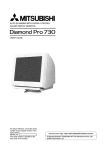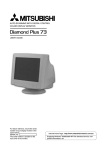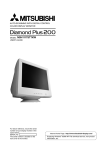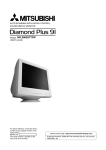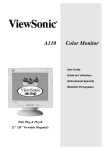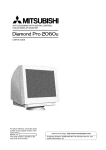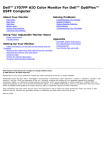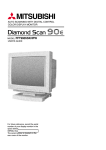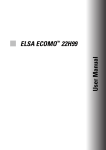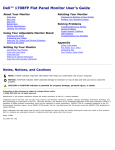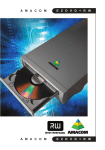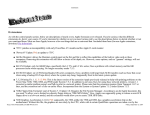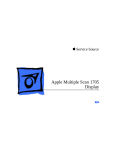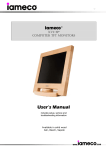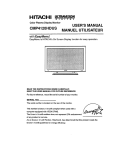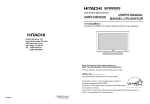Download Mitsubishi Electronics NSB1107STTUW User's Manual
Transcript
AUTO-SCANNING WITH DIGITAL CONTROL COLOR DISPLAY MONITOR MODEL NSB1107STTUW USER’S GUIDE For future reference, record the serial number of your display monitor in the space below: SERIAL No. The serial number is located on the rear cover of the monitor. Internet Home Page: http://www.mitsubishi-display.com/ ® Supplying Windows 95/98 INF File download service, new product information, etc. -2- CONTENTS 1.1 Features ........................................................ 6 CAUTION 1.2 Internal Preset Memory Capability ................ 7 The power cord provided with this monitor is designed for safety and must be used with a properly grounded outlet to avoid possible electrical shock. 1.3 Power Management Function ....................... 7 Do not remove the monitor cabinet as this can expose you to very high voltages and other hazards. 1.6 Cleaning Your Monitor .................................. 7 1.4 DDC .............................................................. 7 1.5 Location Considerations ............................... 7 1.7 Unpacking ..................................................... 8 1.8 Tilt/Swivel Base ............................................. 8 Screen Position Adjustment .......................... 8 1.9 Quick Operation Chart .................................. 8 2. PART NAME ............................................................ 9 2.1 Control Names .............................................. 9 2.2 Function ........................................................ 9 MANUFACTURER DECLARATION FOR CE-MARKING: We, Mitsubishi Electric Corp., declare under our sole responsibility, that this product is in conformity with the following standards: EN60950 EN55022 Class B EN50082-1 EN61000-3-2 EN61000-3-3 following the provisions of: 73/23/EEC Low Voltage Directive 89/336/EEC EMC Directive 3. INSTALLATION AND CONNECTION ..................... 10 3.1 AC Power Connection ................................... 10 3.2 Signal Cable Connection .............................. 10 3.2.1 Connecting to any IBM VGA Compatible System ................................................... 10 3.2.2 Connecting to an Apple Macintosh Computer ............................................... 10 3.2.3 Connecting to a Unix Workstation & Third Party Graphics Card ..................... 10 3.2.4 BNC Connection .................................... 11 WARNING! 3.3 USB System Basic Application ..................... 11 This product is not designed for use in life support devices and Mitsubishi Electric corporation makes no representations to the contrary. Life support devices are those devices which are used to measure, diagnose, or evaluate the tissue, systems or functions of the human body; or other devices employed to support or sustain life or good health. 3.4 Installation of USB Function .......................... 12 4. OSD(On Screen Display) FUNCTIONS .................. 14 4.1 How to adjust the screen .............................. 14 4.2 Adjustment Items .......................................... 15 5. TROUBLESHOOTING ............................................ 19 6. SPECIFICATIONS ................................................... 21 7. APPENDIX .............................................................. 22 Trademark 7.1 Monitor Signal Input Connector (DB9-15P) .. 22 IBM, PC, PS/2, PS/V, Personal System/2 are registered trade- 7.2 SC-B104 Signal Cable .................................. 22 marks of International Business Machines Corp. Apple Macintosh is a registered trademark of Apple Computer, Inc. Quadra is a trademark of Apple Computer, Inc. UNIX is a registered trademark in the United States and other countries, licensed exclusively through X/Open Company Limited. ENERGY STAR is a U.S. registered mark. 7.3 Optional Macintosh Adapter AD-A205 settings . 22 © 1999 MITSUBISHI ELECTRIC CORPORATION -3- ENGLISH 1. INTRODUCTION ..................................................... 6 As an ENERGY STAR Partner, Mitsubishi Electric Corporation has determined that this product meets the ENERGY STAR guidelines for energy efficiency. RADIO INTERFERENCE REGULATIONS STATEMENT FOR U.S.A. This equipment has been tested and found to comply with the limits for a Class B digital device, pursuant to Part 15 of the FCC Rules. These limits are designed to provide reasonable protection against harmful interference in a residential installation. This equipment generates, uses and can radiate radio frequency energy and, if not installed and used in accordance with the instructions, may cause harmful interference to radio communications. However, there is no guarantee that interference will not occur in a particular installation. If this equipment does cause harmful interference to radio or television reception, which can be determined by turning the equipment off and on, the user is encouraged to try to correct the interference by one or more of the following measures: - - 高調波ガイドライン適合品 この装置は、情報処理装置等電波障害自主規制協議会 (VCCI)の基準に基づくクラスB情報技術装置です。この装置 は、家庭環境で使用することを目的としていますが、この装 置がラジオやテレビジョン受信機に近接して使用されると、 受信障害を引き起こすことがあります。 取扱説明書に従って正しい取り扱いをしてください。 Reorient or relocate the receiving antenna. Increase the separation between the equipment and receiver. Connect the equipment into an outlet on a circuit different from that to which the receiver is connected. Consult the dealer or an experienced radio/TV technician for help. Energy 2000 Labeling Award THIS PRODUCT HAS BEEN TESTED AND FOUND TO COMPLY WITH THE LIMITS WITH SIGNAL CABLE SC-B104. USE IT TO REDUCE THE POSSIBILITY OF CAUSING INTERFERENCE TO RADIO, TELEVISION, AND OTHER ELECTRIC DEVICES. NO USER SERVICEABLE PARTS INSIDE. DO NOT ATTEMPT TO MODIFY THIS EQUIPMENT. IF MODIFIED, YOUR AUTHORITY TO OPERATE THIS EQUIPMENT MIGHT BE VOIDED BY FCC. Declaration of Conformity - United States only Product Name: Type: Brand Name: 22 in. (55cm) Color Display Monitor NSB1107STTUW MITSUBISHI This device complies with Part 15 of the FCC Rules. Operation is subject to the following two conditions: (1) this device may not cause harmful interference, and (2) this device must accept any interference received, including interference that may cause undesired operation. For questions regarding this declaration, contact: Mitsubishi Electronics America, Inc. 5665 Plaza Drive, P.O. Box 6007, Cypress, California 90630-0007 or, call 714-220-2500 To identify this product, refer to the model number found on the product. -4- Below you will find a brief summary of the environmental requirements met by this product. The complete environmental criteria document may be ordered from: Congratulations! You have just purchased a TCO’99 approved and labelled product! Your choice has provided you with a product developed for professional use. Your purchase has also contributed to reducing the burden on the environment and also to the further development of environmentally adapted electronics products. Environmental requirements Flame retardants Flame retardants are present in printed circuit boards, cables, wires, casings and housings. Their purpose is to prevent, or at least to delay the spread of fire. Up to 30% of the plastic in a computer casing can consist of flame retardant substances. Most flame retardants contain bromine or chloride, and those flame retardants are chemically related to another group of environmental toxins, PCBs. Both the flame retardants containing bromine or chloride and the PCBs are suspected of giving rise to severe health effects, including reproductive damage in fish-eating birds and mammals, due to the bio-accumulative* processes. Flame retardants have been found in human blood and researchers fear that disturbances in foetus development may occur. The relevant TCO’99 demand requires that plastic components weighing more than 25 grams must not contain flame retardants with organically bound bromine or chlorine. Flame retardants are allowed in the printed circuit boards since no substitutes are available. Why do we have environmentally labelled computers? In many countries, environmental labelling has become an established method for encouraging the adaptation of goods and services to the environment. The main problem, as far as computers and other electronics equipment are concerned, is that environmentally harmful substances are used both in the products and during their manufacture. Since it is not so far possible to satisfactorily recycle the majority of electronics equipment, most of these potentially damaging substances sooner or later enter nature. There are also other characteristics of a computer, such as energy consumption levels, that are important from the viewpoints of both the work (internal) and natural (external) environments. Since all methods of electricity generation have a negative effect on the environment (e.g. acidic and climate-influencing emissions, radioactive waste), it is vital to save energy. Electronics equipment in offices is often left running continuously and thereby consumes a lot of energy. Cadmium* * Cadmium is present in rechargeable batteries and in the colour-generating layers of certain computer displays. Cadmium damages the nervous system and is toxic in high doses. The relevant TCO’99 requirement states that batteries, the colour-generating layers of display screens and the electrical or electronics components must not contain any cadmium. What does labelling involve? This product meets the requirements for the TCO’99 scheme which provides for international and environmental labelling of personal computers. The labelling scheme was developed as a joint effort by the TCO (The Swedish Confederation of Professional Employees), Svenska Naturskyddsforeningen (The Swedish Society for Nature Conservation) and Statens Energimyndighet (The Swedish National Energy Administration). Mercury* * Mercury is sometimes found in batteries, relays and switches. It damages the nervous system and is toxic in high doses. The relevant TCO’99 requirement states that batteries may not contain any mercury. It also demands that mercury is not present in any of the electrical or electronics components associated with the labelled unit. Approval requirements cover a wide range of issues: environment, ergonomics, usability, emission of electric and magnetic fields, energy consumption and electrical and fire safety. CFCs (freons) The relevant TCO’99 requirement states that neither CFCs nor HCFCs may be used during the manufacture and assembly of the product. CFCs (freons) are sometimes used for washing printed circuit boards. CFCs break down ozone and thereby damage the ozone layer in the stratosphere, causing increased reception on earth of ultraviolet light with e.g. increased risks of skin cancer (malignant melanoma) as a consequence. The environmental demands impose restrictions on the presence and use of heavy metals, brominated and chlorinated flame retardants, CFCs (freons) and chlorinated solvents, among other things. The product must be prepared for recycling and the manufacturer is obliged to have an environmental policy which must be adhered to in each country where the company implements its operational policy. The energy requirements include a demand that the computer and/or display, after a certain period of inactivity, shall reduce its power consumption to a lower level in one or more stages. The length of time to reactivate the computer shall be reasonable for the user. Labelled products must meet strict environmental demands, for example, in respect of the reduction of electric and magnetic fields, physical and visual ergonomics and good usability. Lead* * Lead can be found in picture tubes, display screens, solders and capacitors. Lead damages the nervous system and in higher doses, causes lead poisoning. The relevant TCO´99 requirement permits the inclusion of lead since no replacement has yet been developed. * ** -5- Bio-accumulative is defined as substances which accumulate within living organisms Lead, Cadmium and Mercury are heavy metals which are Bio-accumulative. ENGLISH TCO Development SE-114 94 Stockholm, Sweden Fax: +46 8 782 92 07 Email (Internet): [email protected] Current information regarding TCO’99 approved and labelled products may also be obtained via the Internet, using the address: http://www.tco-info.com/ 1 INTRODUCTION Congratulations on your purchase of the high resolution color monitor. We designed this monitor to provide you with years of reliable trouble-free operation. This guide tells you how to connect, adjust and care for your monitor. This guide also provides technical specifications and instructions for troubleshooting any basic problems you may experience with your monitor. 1.1 Features This monitor is a 55cm/22"(51cm/20" Diagonal Viewable Image) intelligent, microprocessor-based monitor compatible with most analog RGB (Red, Green, Blue) display standards. It provides crisp text and vivid color graphics with both PC and Macintosh platforms. • The monitor’s wide auto-scanning compatibility range makes it possible to upgrade video cards or software without purchasing a new monitor. • Digitally controlled auto-scanning is done using an internal microprocessor, for horizontal scan frequencies between 30kHz and 121kHz, and vertical scan frequencies between 50Hz and 160Hz. The microprocessor-based intelligence allows the monitor to operate in each frequency mode with the precision of a fixed frequency monitor. • The monitor contains resident memory for pre-programmed screen display standards and is also capable of storing additional user adjustment parameters. • The monitor is capable of producing a non-interlaced maximum addressable resolution format of 2048 dots x 1536 lines. This display is well suited for windowing environments. • Because of the analog signal inputs, the monitor can display an unlimited palette of colors that can be manually adjusted to suit your specific needs. • The monitor has a power management function accorded to VESATM-DPMSTM-standard. To save energy, the monitor must be connected to a system compliant with the VESATM -DPMSTM-standard. (Refer to your computer and/or video card instructions for proper operation.) • To ensure ease of installation and ongoing use, the monitor features On Screen Display (OSD) of all monitor set-up and adjustment functions. • For use in a variety of applications, the monitor complies with UL 1950, CSA C22.2 No.950 and EN60950 for safety, FCC Class-B, VCCI Class-B and EN55022 Class-B for EMI, MPR-II, ISO 9241-3, ISO9241-7 and ISO9241-8 for ergonomics. The monitor also complies with TCO’99 guideline for environmental safe use. • The world's standard DIAMONDTRON NF CRT upgraded and pure picture images. -6- • The monitor complies with Video Electronics Standards Association (VESATM) DDCTM1/2B(EDID) specification. If your computer is Plug & Play compliant setup will be done automatically. • Fine 0.24mm aparture grille pitch/Maximum addressable resolution of 2048 x 1536. • USB self-powered hub with 2 upstream ports and 3 downstream ports. 1.2 1.5 Internal Preset Memory Capability When setting up and using the monitor, keep the following in mind: • For optimum viewing, avoid placing the monitor against a bright background or where sunlight or other light sources may reflect on the display area of the monitor. Place the monitor just below eye level. • Place the monitor away from strong magnetic or electromagnetic fields, such as high capacity transformers, electric motors, large current power lines, steel pillars, etc.... Magnetism can cause distortion in the picture and/or color purity. • Avoid covering the slots or openings of the monitor. Allow adequate ventilation around the monitor so the heat from the monitor can properly dissipate. Avoid putting the monitor into any enclosure that does not have adequate ventilation. • Avoid exposing the monitor to rain, excessive moisture, or dust, as this can cause a fire or shock hazard. • Avoid placing the monitor, or any other heavy object, on the power cord. Damage to the power cord can cause a fire or electrical shock. • When transporting the monitor, handle it with care. Table 1. Memory Buffer Factory Presets 1.3 N.I. N.I. N.I. N.I. N.I. N.I. N.I. N.I. N.I. N.I. N.I. Fh(kHz) Fv (Hz) 31.5 60.0 53.7 85.1 60.0 75.0 68.7 85.0 68.7 75.1 80.0 75.0 91.1 85.0 93.8 75.0 106.3 85.0 112.5 75.0 120.4 85.0 Polarity H V – – + + + + + + – – + + + + + + + + – + – – Power Management Function 1.6 The monitor has a power management function which reduces the power consumption of the monitor when not in use. There are three reduced power level modes. Power saving modes are invoked by a VESA DPMScompliant computer. Check your computer's manual for setting this function. Mode Normal Stand-By Suspend Off 1.4 When cleaning the monitor, please follow these guidelines: • Always unplug the monitor before cleaning. • Wipe the screen and cabinet front and sides with a soft cloth. • If the screen requires more than dusting, apply a household window cleaner to a soft cloth to clean the monitor screen. Power(With no USB operation) Power-On Indicator 155 W 15 W 15 W 3W Cleaning Your Monitor Green Amber Amber Amber DDC CAUTION TM TM The monitor includes the VESA DDC 1 and DDC 2B feature. DDC (Display Data Channel) is a communication channel over which the monitor automatically informs the computer system about its capabilities (e.g. each supported resolution with its corresponding timing). DDC is routed through previously unused pins of the 15-pin VGA connector. The system will “Plug and Play” if both monitor and computer implement the DDC protocol. Plug & Play does not operate when BNC inputs are used. -7- • Do not use benzene, thinner or any volatile substances to clean the unit as the finish may be permanently marked. • Never leave the monitor in contact with rubber or vinyl for an extended time period. • Do not spray directly on the screen as cleaner may drip into the monitor and damage the circuitry. • Never use an abrasive cleaner on the screen surface as this will damage the anti-reflection coating. ENGLISH To minimize adjustment needs, the factory has preset popular display standards into the monitor, as shown in Table 1. If any of these display standards are detected, the picture size and position are automatically adjusted. All of the factory presets may be overwritten by adjusting the user controls. This monitor is capable of automatically storing up to 15 additional display standards. The new display information must differ from any of the existing display standards by at least 1kHz for the horizontal scan frequency or 1Hz for the vertical scan frequency or the sync signal polarities must be different. PRESET TIMING 640 x 480 800 x 600 1024 x 768 1024 x 768 1152 x 870 1280 x 1024 1280 x 1024 1600 x 1200 1600 x 1200 1920 x 1440 1800 x 1350 Location Considerations 1.7 1.9 Quick Operation Chart Unpacking To summarize the steps in connecting your computer with the color monitor and setting the necessary controls and switches, refer to the chart below. After you unpack the box you should have all of the items indicated in Figure 1. Save the box and packing materials in case you transport the monitor. Complete and mail in warranty cards. 2 1 3 Connect the color monitor and computer with the necessary cords and cables. See Section 3. INSTALLATION AND CONNECTION 5 4 6 Turn on the color monitor. Turn on the computer. Figure 1. 4. User's Guide (this document) 5. Warranty-Card 6. Questionnaire-Card 1. Color Monitor 2. AC Power Cord 3. Signal Cable SC-B104 Set the controls. See Section 4. OSD(On Screen Display) FUNCTIONS OK 1.8 Tilt/Swivel Base If a problem appears. OK The monitor comes with a tilt/swivel base. This enables you to position the monitor at the best angle and tilt for maximum viewing comfort. See Section 5. TROUBLESHOOTING If the problem persists. Screen Position Adjustment Adjust the tilt and rotation of the monitor by placing your hands at opposite sides of the case. You can adjust the monitor 90 degrees right or left, 10 degrees up or 5 degrees down, as shown below. Call for your authorized MITSUBISHI Product Support. 10 90 90 5 Figure 2. CAUTION Keep your fingers away from the pivot area of the tilt/swivel base. -8- 2 PART NAME ENGLISH 2.1 Control Names See Figures 3 and 4 for the location of the user controls, indicator and connectors. Each part is identified by number and is described individually. REAR FRONT D-SUB BNC A B 1 R G B COMP. HD VD 2 D-SUB BNC A B 1 R G B COMP. HD VD 2 Figure 4 Figure 3 2.2 Function 1. POWER SWITCH: A push-on / push-off switch for AC power. 2. POWER-ON INDICATOR: This indicator illuminates green when AC power is on, and illuminates amber when the monitor is in the power management modes. 3. INPUT CONNECTOR SELECT/OSD OFF BUTTON: • Without OSD screen, push to select the signal input connector, BNC or D-SUB. • With OSD screen, push to turn the OSD screen off. If only one input is used, the monitor will select it automatically. 4. DOWN BUTTON: Push to select group icon. 5. ITEM SELECT BUTTON: Push to select the item icon. 6. FUNCTION ADJUST BUTTONS: Push the adjust buttons to adjust the image on the screen. 7. USB DOWNSTREAM PORT: To connect to USB equipped peripherals, e.g, USB camera, keyboard, printer, etc. -9- 8. AC POWER CONNECTOR 9. SIGNAL INPUT CONNECTOR (DB9-15P) 10. SIGNAL INPUT CONNECTORS (BNC) 11. USB UPSTREAM PORTS: To connect to USB equipped computer(s). 12. USB DOWNSTREAM PORTS: To connect to USB equipped peripherals, e.g, USB camera, keyboard, printer, etc. 3 INSTALLATION AND CONNECTION On the back of the monitor four kinds of plug-in connections are provided: AC power connector for the AC input, DB915P connector and BNC connector for video signal input and USB ports for USB communication. 3.2.2 Connecting to An Apple Macintosh Computer 3.1 For Macintosh Adapter AD-A205, contact your dealer. Figure 6 shows the SC-B104 cable and AD-A205 Adapter(option) to the video port in an Apple Macintosh. AC Power Connection 1. 2. One end of the AC power cord is connected to the AC power connector on the back of the monitor. The other end is plugged into a properly grounded three-prong AC outlet. The monitor’s auto-sensing power supply can automatically detect 100-120V AC or 220-240V AC and 50 or 60Hz. 3. 3.2 Signal Cable Connection The DB9-15P(VGA) connector is provided for compatible analog RGB outputs from your computer. Apple Macintosh computers can also be interfaced with using the optional Mitsubishi Macintosh adapter AD-A205. 4. 5. 3.2.1 Connecting to Any IBM VGA Compatible System 6. 7. Figure 5 shows the SC-B104 cable connection to the Video Graphics Array (VGA) port in an IBM Personal System/2® series, or any VGA compatible system. Power off, both the monitor and the computer. Set the DIP switches of Macintosh Adapter according to the setting chart. (See Section 7.3 Optional Macintosh Adapter ADA205 settings) Connect the 15-pin (DB-15P) end of the AD-A205 Adapter to the straight 15-pin connector on the Macintosh video port on the computer or on the video board. Connect the sub-miniature 15-pin (DB9-15P) end of the AD-A205 Adapter to the SC-B104 cable. Connect the other end of the SC-B104 cable to the DB9-15P receptacle on the back of the monitor. Power on the monitor, then the Macintosh. After using the system, power off the monitor, then the Macintosh. D-SUB BNC A B 1 R G B COMP. HD Computer VD 2 1. 2. 3. 4. 5. Power off, both the monitor and the computer. Connect the one end of the SC-B104 cable to the DB9-15P connector on the VGA controller card. Connect the other end of the SC-B104 cable to the DB9-15P receptacle on the back of the monitor. Power on the monitor, then the computer. After using the system, power off the monitor, then the computer. D-SUB BNC R Power Cord • Computer D-SUB BNC A B 1 R B G COMP. HD VGA Compatible System VD 2 D-SUB BNC R G B COMP. HD • VD DB9-15P Power Cord Apple Macintosh Computer Cable SC-B104 Figure 5 CAUTION The socket-outlet shall be installed near the equipment and shall be easily accessible. During servicing, disconnect the plug from the socket-outlet. Méme si le moniteur est mis hors tension il reste toujours alimenté. La prise secteur devrait ainsi ètre facilement accssible en cas d'urgence. - 10 - G B COMP. HD VD Macintosh Adapter AD-A205 (Option) Cable SC-B104 Figure 6 For the Apple Macintosh Computers having a VGA compatible port, steps 2 through 4 are not necessary. Connect the end of the signal cable to the port directly. In case of Apple Macintosh G3 series, use "Control Panel" of "Apple Menu" when selecting a resolution. If select the resolution from "Control Bar", no screen may be displayed and the computer may freeze. 3.2.3 Connecting to a Unix Workstation & Third Party Graphics Card 3.2.4 BNC Connection (1) COMPOSITE SYNC ON GREEN VIDEO SIGNAL (3 wires): Connect the R, G and B video signals to the BNC connectors on the back of the monitor. Figure 7 shows the SC-B104 or 75Ω coaxial cable (not supplied) connection to the graphics video card (PC-CAD and workstation). 3. 4. 5. BNC Power off, both the monitor and the computer. Connect one end of the SC-B104 cable or the 75Ω coaxial cable to the output connector on the computer, or on the video board. Connect the other end of the SC-B104 cable or the 75 Ω coaxial cable to the DB9-15P receptacle or the BNC receptacles on the back of the monitor. Power on the monitor, then the computer. After using the system, power off the monitor, then the computer. B A R 1 B G BNC B R B G COMP. HD VD 2 BNC 1 R 1 D-SUB B VD (2) EXTERNAL COMPOSITE SYNC SIGNAL(4 wires): Connect the R, G and B video signals and the Composite sync signal to BNC connectors on rear panel, respectively. A A COMP. HD 2 COMP. HD B G High Resolution Graphic Video Card VD 2 D-SUB BNC R G Power Cord B COMP. HD VD (3) SEPARATE HORIZONTAL AND VERTICAL SYNC SIGNALS (5 wires): Connect the R, G and B video signals and the horizontal and vertical sync signals to the BNC connectors on the rear panel. High Resolution Graphic Video Card 75Ω coaxial cable Cable SC-B104 BNC Figure 7 A B 1 R G B COMP. HD VD 2 3.3 USB System Basic Application FRONT BACK Power Cord D-SUB BNC A B R 1 B G COMP. HD VD 2 Downstream Ports Downstream Port D-SUB A B 1 BNC R USB Cable Upstream Ports USB Cable G B COMP. HD VD 2 Signal Cable Signal Cable NOTE Computer Scanner Keyboard Camera - 11 - The computer is required to have Windows® 98 or later installed and USB functions. When connecting one computer, either Upstream port A or B is available. The Upstream port is automatically matched with the active video input. ENGLISH 1. 2. 3.4 Installation of USB Function (a) Disconnect and connect the USB cable to the upstream port of the display monitor. (b) Cycle power of the display monitor off then on. The following procedure permits your computer to recognize or "enumerate"(A USB term) the Mitsubishi USB HUB. 1. 2. Power on the display monitor and then the computer. NOTE If the mark appears with “Generic USB HUB”, then enumeration was unsuccessful. Select “Generic USB HUB” marked with mark and click “Remove” and “Refresh”. After that, the enumeration is automatically started. Start "Enumeration" from the Windows® Desktop. NOTE • During the enumeration of Mitsubishi USB Hub, connect the keyboard and mouse, to the computer and not to the downstream ports on the display monitor. After the enumeration, the keyboard and mouse can be used by connecting to the downstream ports, if they are USBcompliant. • Do not unplug the USB cable during the enumerations. NOTE The enumeration of USB HUB may be necessary for each USB port on the computer. (1) Connect the computer and the display monitor with an USB cable. Figure 8 will appear. (2) Click “Next” on Figure 8 to get Figure 9. (3) Click “Finish” on Figure 9 to complete the enumeration of Mitsubishi USB HUB. Figure 10 Figure 8 3. Enumerate the Mitsubishi Monitor Function which permits Monitor Control(height, width, rotation, etc) via USB, using the following procedure. (1) Insert Windows® 98 CD-ROM into your computer. Then, Figure 11 will appear. Figure 9 You can confirm that “Mitsubishi USB HUB” is successfully enumerated with the following method. • Open “Device Manager” tab in “System” property under “Control Panel”. Confirm that “Generic USB HUB” is listed in “Universal Serial Bus Controller”. If you can’t confirm it, re-enumerate “Mitsubishi USB HUB” again by following (a) or (b). Figure 11 - 12 - (2) Click “Next” on Figure 11 and Figure 12 will appear. ENGLISH Figure 15 Figure 12 You can confirm that Enumeration of Mitsubishi Monitor Function is successfull with the following method. (3) Click “Next” on Figure 12 and Figure 13 will appear. • Open “Device Manager” tab in “System” property under “Control Panel”. Confirm that “HID-compliant Device” and “USB Human Interface Device” are listed in “Human Interface Device”. If you can’t confirm it, reenumerate “Mitsubishi Monitor Function” again by following (a) or (b). (a) Disconnect and connect the USB cable to the upstream port of the display monitor. (b) Cycle power of the display monitor off then on. NOTE If the mark appears with “HID-Compliant Device” and/or “USB Human Interface Device”, the enumeration was unsuccessful. Select “HID-Compliant Device “and/or “USB Human Interface Device marked with mark and click “Remove” and “Refresh”. After that, the enumeration is automatically started. Figure 13 (4) Click “CD-ROM Drive(C)” , and click “Next”. Figure 14 will appear. Generic USB Hub Figure 14 (5) Click “Finish” on Figure 14 and Figure 15 will appear. Click “OK” on Figure 15 to complete Enumeration of Mitsubishi Monitor Function. Figure 16 NOTE The following should be observed in order to use the USB function reliably: • Make sure all connections are made firmly and correctly. • Do not change the Upstream port during the recognition of the monitor or other peripherals. • Close all Windows program before changing the Upstream port or disconnecting USB cable. - 13 - 4 4.1 OSD (On Screen Display) FUNCTIONS How to adjust the screen The monitor has an OSD(On Screen Display) function. The following procedure shows how to adjust the screen using the OSD function. (5)Adjust by pressing (1) Turn on the monitor. or button. (6)If you don't press any button for about ten seconds, the OSD screen will disappear. (2) Press button screen. The OSD can be turned off quickly by pressing button. to display the OSD (3) Select the group icon on Main Menu by pressing . Main Menu (4) Select the item icon on Sub Menu by pressing button. Sub Menu NOTE When pressing both and buttons simultaneously, moving direction of item selection becomes reverse. - 14 - 4.2 Adjustment Items X: Items Function Adjusts the contrast level. Adjusts the black level of the screen Select the desired color from Color 1, Color 2, and Color 3 presets. Adjusts the red-color balances for the selected color. Adjusts the green-color balances for the selected color. Adjusts the blue-color balances for the selected color. Adjusts the color temperature of the image on the screen. Restores the each color gain and color temperature to the factory preset. Adjusts the horizontal size of the image on the screen. Adjusts the horizontal position of the image on the screen. Adjusts the horizontal position of the screen raster. Adjusts the vertical size of the image on the screen. Adjusts the vertical position of the image on the screen. Straightens the left and right sides of the image on the screen. Adjusts the parallelism of the left and right sides of the image on the screen. Adjusts the pincushioning at the top corners of the screen. Adjusts the pincushioning at the bottom corners of the screen. Adjusts the curvature of the left and right sides of the image on the screen. Adjusts the vertical slant or tilt of the screen image. Adjusts the rotation of the image on the screen. Zooms the screen to all sides. Restores to the factory preset level.(See "NOTE" below.) To get a preferable image for your work. Select the black level of the screen. Adjusts the horizontal alignment of the red, green and blue beams. Adjusts the vertical alignment of the red, green and blue beams. Adjusts the upper vertical alignment of the red, green, and blue beams. Adjusts the bottom vertical alignment of the red, green, and blue beams. Adjusts the horizontal alignment of the red, green and blue beams on the right part of screen. Adjusts the horizontal alignment of the red, green and blue beams on the left part of screen. Adjusts the purity of the top-left corners of the screen. Adjusts the purity of the top-right corners of the screen. Adjusts the purity of the bottom-left corners of the screen. Adjusts the purity of the bottom-right corners of the screen. When setting to ON, the moire level on the screen can decreased by the MOIRE CANCEL LEVEL. MOIRE CANCEL LEVEL Adjusts the moire level on the screen. CLAMP PULSE POSITION Uses this function to eliminate excessive green or white background that may occur when both Sync-On-Green and external sync signals are applied to the monitor. DEGAUSS Eliminates possible color shading or impurity. POWER SAVE When setting to ON, the power consumption of the monitor will be reduced when not in use if your computer is set for power management. CONTROL LOCK Locks the OSD function except for "BRIGHT" and "CONTRAST". OSD POSITION Moves the OSD screen position. ALL RESET Restores all items to the factory preset level.(See "NOTE" below.) GTF AUTO ADJUST Adjusts the screen size and distortion automatically. DIAGNOSIS Indicates the current scanning frequency, factory or user preset timing number, and signal input connector. LANGUAGE Selects the language used on OSD screen. USB UP-STREAM Selects the Upstream port which you want to use. USB PORT COMBINATION Selects the combination of the Upstream port and signal input connector. A. Press "GEOMETRY RESET" to restore to the factory preset level. B. Press and buttons together, to restore to the factory preset level. C. Press "ALL RESET" to restore to the factory preset level. D. Set data does not change by the change of the signal timing. If a non-Factory Preset timing is used, "GEOMETRY RESET" and "ALL RESET" do not work. - 15 - A X X X X X X X X X X X X - B C D X X X X X X X X X X X X X X X X X X X X X X X X X X X X X X X X X X X X X X X X X X X X X X X X X X X X X X - X X X X X X X X X X - - X X X X - X - X X X X X X X X X X X X X - X X X - X X - X X X X X - ENGLISH CONTRAST BRIGHT COLOR NO R-GAIN G-GAIN B-GAIN COLOR TEMPERATURE COLOR RESET HORIZ-SIZE HORIZ-PHASE HORIZ-POSITION VERT-SIZE VERT-POSITION PINCUSHION KEYSTONE TOP-PIN BOTTOM-PIN PIN-BALANCE KEY-BALANCE ROTATION ZOOM GEOMETRY RESET TEXT MODE BLACK LEVEL HORIZ-CONVERGENCE VERT-CONVERGENCE VERT-CONV-TOP VERT-CONV-BOTTOM HORIZ-CONV-RIGHT HORIZ-CONV-LEFT CORNER PURITY (TL) CORNER PURITY (TR) CORNER PURITY (BL) CORNER PURITY (BR) MOIRE CANCEL Available Group Icon Item Icon Item CONTRAST BRIGHT Press the Minus Button Press the Plus Button To decrease the contrast. To increase the contrast. To decrease the brightness. To increase the brightness. COLOR NO To select color 1, color 2, color 3. R-GAIN To decrease red color level of the color mode selected by "COLOR NO". To increase red color level of the color mode selected by "COLOR NO". G-GAIN To decrease green color level of the color mode selected by "COLOR NO". To increase green color level of the color mode selected by "COLOR NO". B-GAIN To decrease blue color level of the color mode selected by "COLOR NO". To increase blue color level of the color mode selected by "COLOR NO". COLOR TEMPERATURE To decrease the color temperature of the color mode selected by "COLOR NO". HORIZ-SIZE To narrow the width of the image on the screen. To increase the color temperature of the color mode selected by "COLOR NO". To restore the color-gain and color temperature of the color mode selected by "COLOR NO" to the factory preset. To expand the width of the image on the screen. HORIZ-PHASE To move the image on the screen to the left. To move the image on the screen to the right. To move the image to the left. To move the image to the right. To narrow the height of the image on the screen. To expand the height of the image on the screen. To move the image down. To move the image up. TOP-PIN To collapse the center of the image. To decrease the width at the top of the screen image and to increase the width at the bottom. To expand the width of the screen image near the corners of top. To expand the center of the image. To increase the width at the top of the screen image and to decrease the width at the bottom. To narrow the width of the screen image near the corners of top. BOTTOM-PIN To expand the width of the screen image near the corners of bottom. To narrow the width of the screen image near the corners of bottom. PIN-BALANCE To move the top and bottom of the screen image to the right. To move the top and bottom of the screen image to the left. KEY-BALANCE To make the screen slant to the left. To make the screen slant to the right. ROTATION To rotate the image counterclockwise. To rotate the image clockwise. ZOOM To narrow the screen to all sides. To expand the screen to all sides. COLOR RESET HORIZ-POSITION VERT-SIZE VERT-POSITION PINCUSHION KEYSTONE To restore to factory preset level. GEOMETRY RESET - 16 - Group Icon Item Icon Press the Minus Button Press the Plus Button Item TEXT MODE To select "LOW" mode. To select "SMOOTH" mode. To select "HIGH" mode. HORIZ-CONVERGENCE To adjust the horizontal beam alignment on the full screen area. VERT-CONVERGENCE To adjust the vertical beam alignment on the full screen area. VERT-CONV-TOP To adjust the vertical beam alignment on the upper screen area. VERT-CONV-BOTTOM To adjust the vertical beam alignment on the lower screen area. HORIZ-CONV-RIGHT HORIZ-CONV-LEFT To adjust the horizontal beam alignment on the right screen area. To adjust the horizontal beam alignment on the left screen area. CORNER PURITY(TL) To adjust the purity condition on the top-left corner. CORNER PURITY(TR) To adjust the purity condition on the top-right corner. CORNER PURITY(BL) To adjust the purity condition on the bottom-left corner. CORNER PURITY(BR) To adjust the purity condition on the bottom-right corner. MOIRE CANCEL To select the Moire Cancel mode off. To select the Moire Cancel mode on. MOIRE CANCEL LEVEL To decrease the level of the moire-clear wave. CLAMP PULSE POSITION To eliminate an excessive green or white-back ground that may occur when both Sync-On-Green and external sync signals are applied to the monitor. To clamp the video signal at the back of the H-Sync pulse. If you To clamp the video signal at connect to an older Macintosh, you the front of the H-Sync pulse. may need to press plus button. DEGAUSS To eliminate possible color shading or impurity due to magnetic effects. To select the power-save mode. (Your computer must be set for power management.) POWER SAVE To select the constant power consumption mode. CONTROL LOCK To unlock the OSD function. To lock the OSD function except for "BRIGHT" and "CONTRAST". To move the OSD screen position in a counter clockwise direction. To move the OSD screen position in a clockwise direction. OSD POSITION ALL RESET GTF AUTO ADJUST DIAGNOSIS LANGUAGE To restore all items to the factory preset. To adjust screen size, position and distortions automatically. To show the current scanning frequency, Preset No., and signal input connection. To choose the language used on OSD. ENG......English, FRA......French, ITA......Italian, GER......German, ESP......Spanish, JPN......Japanese NOTE CONTROL LOCK: This is to lock the OSD function to keep the OSD screen image you set. Press plus button to lock the OSD function. You can adjust only "BRIGHT" and "CONTRAST" at the condition. Press minus button to unlock the locked condition. GTF: This function is available when the computer has the GTFTM function according to the VESA®GTFTM standard. - 17 - ENGLISH BLACK LEVEL To select "SHARP" mode. Group Icon Item Icon Item Press the Minus Button The USB functions of the computer connected to Upstream port ROOT-A become active. Press the Plus Button The USB functions of the computer connected to Upstream port ROOT-B become active. NOTE USB UP-STREAM The active Upstream port in active is colored blue on the OSD screen. In case that either the Upstream port ROOT-A or ROOT-B is chosen by this function, the auto-change of the Upstream port is not available. It may take about 15 seconds until the USB devices have been recognized by the computer after the Upstream port is changed. Make sure the operation of the devices connected to the downstream ports before changing USB Upstream ports. It may take approximately 15 seconds max. until the devices have been recognized by the computer and start to operate after the Upstream ports are changed. Do not change the Upstream ports during recognition to prevent errors of the operation of devices or application software. Close all Windows programs before changing Upstream ports. The Upstream port ROOT-A is assigned for signal input connector "D-SUB" and ROOT-B is assigned for "BNC" The Upstream port ROOT-A is assigned for signal input connector "BNC" and ROOT-B is assigned for "D-SUB". NOTE USB PORT COMBINATION This function is to change the Upstream port automatically in corresponding to the change of signal input connector. This function is only available in case that both the Upstream ports are connected to the computers. It may takes 15 seconds until the USB devices have been recognized by the computer after the Upstream port is changed. In case that the computer chosen enters into a power management mode, the signal input connector and Upstream port are changed to others automatically. When the Upstream port which is connected to the computer not displays on the screen is selected, the operation of the USB devices connected to the Downstream ports is not shown on the screen of the display monitor. NOTE USB Monitor Control will be available when installing "USB Monitor Control Software" into the computer. The "USB Monitor Control Software" can be downloaded from Mitsubishi Internet Home Page: http://www.mitsubishi-display.com/ - 18 - 5 TROUBLESHOOTING PROBLEM ITEMS TO CHECK LOCATION • Contrast and brightness controls. • Front (OSD) LED Off • Power switch. • AC power cord disconnected. • Front • Rear LED On (Amber) • Signal cable disconnected. • BNC cables are misconnected or the green cable is disconnected. • Computer power switch. • Power management function is active. • • • • Rear Check the graphics adapter and cables Computer Press any key on the keyboard or move the mouse. • Signal cable disconnected. • BNC cables are misconnected or the green cable is disconnected. • Computer power switch. • Power management function is active. • • • • Rear Check the graphics adapter and cables Computer Press any key on the keyboard or move the mouse. • Input signal frequency range is too high or too low for the monitor to synchronize with. • Check the specification of graphics adapter • Do "GEOMETRY-RESET" or "ALL RESET" for a standard signal. • Adjust HORIZ-SIZE, VERT-SIZE, HORIZ-PHASE, and VERT-POSITION with non-standard signals. • Monitor may not be able to get full-screen image depend on signal. In this case, please select other resolution, or other vertical refresh timing. • Make sure you wait a few seconds after adjusting the size of the image before changing or disconnecting the signal. • Front (OSD) • Front (OSD) • [Universal serial bus controller] is not listed in [Device Manager]. • Confirm that Windows98 is installed into the computer. • [Generic USB HUB] is not listed in [Device Manager]. • Make sure of the cable connections. • Restart the computer. • Turn off the monitor and turn on then. • Disconnect all the cables connected to theUpstream ports and re-connect then. • On the OSD screen, the Upstream port to which the USB device you want to use is connected is not colored by blue. • Select the Upstream port by using the OSD screen, "Upstream port selection" LED On (Green) No picture The following message appeared. ATTENTION NO NO SIGNAL H OFF V OFF PLEASE CHECK PLEASE CHECK INPUT SIGNAL SIGNAL OR OR INPUT CONNECTION. The following message appeared. ATTENTION SIGNAL FREQUENCY IS OUT OF RANGE. FH 24.8KHz FH 24.8KHz FV 43.0Hz PLEASE CHANGE SIGNAL TIMING. Abnormal picture Display is missing, center shifts, or too small or too large of a display size No operation of the USB devices - 19 - ENGLISH Before calling your Authorized Product Support, please check that the items below are properly connected or set. In case of using a non-standard signal, please check the pin assignments and the signal timing of your computer with the specification outlined in Section 6. SPECIFICATIONS and Section 7. APPENDIX. ITEMS TO CHECK PROBLEM LOCATION Abnormal Picture • Thin vertical black lines on one or both sides of the screen. This minor condition is caused by grille element overlap which can occur during shipping. Black vertical lines are visible on the screen. Two fine horizontal lines are visible on the screen. • – Position an open white window over the affected area of the screen and maximize the brightness and contrast controls. This will cause localized heating of the overlap which will clear in a few minutes. Be sure to readjust the brightness and contrast controls back to the normal viewing levels after this procedure. • The 2 very faint thin lines across the screen are normal. They are caused by the aperture grille stabilization filaments(Damper Wires) which are required for all aperture grille CRTs’. • – Aperture Grille Shadow of Damper Wires Electron Gun Damper Wires Shadow of Damper Wires A buzzing sound when power on. Aperture Grille Type • A brief vibration or hum sound that is heard just after power up is normal. This is caused by the automatic degaussing function. This sound will be heard each time the monitor is powered up from a cold start and each time the manual degauss button is used. - 20 - • – 6 SPECIFICATIONS Size CRT 55cm/22"(51cm/20" Diagonal Viewable Image) Mask type Aperture grille Gun In-line Deflection angle 90° Phosphors Red, Green, Blue EBU (medium short persistence) Aperture grille pitch 0.24mm Phosphor pitch 0.25mm Face Plate Focusing method Anti-glare, Anti-reflection and Anti-static coating Dynamic Beam Forming (DBF) INPUT SIGNAL Video Sync 0.7Vp-p analog RGB Sync. on Green or separate H, V sync., or Composite sync SIGNAL INTERFACE Input Connectors Input Impedance 5BNC, DB9-15P 75Ω (video), 2.2kΩ (sync.) Self-powered HUB complying with Universal Serial Bus Specification Rev.1.0 Function USB Interface 2 Upstream ports/12Mbps 3 Downstream ports/12Mbps, 1.5Mbps (500mA max. per each Downstream port) SCANNING Horizontal 30 - 121kHz FREQUENCY Vertical 50 - 160Hz RESOLUTION (HxV) 2048 dots x 1536 lines Non-Interlaced maximum addressable resolution format at 75Hz WARM-UP TIME 30 minutes to reach optimum performance level BRIGHTNESS 100cd/m2, standard full white video signal at 9300K (+ 8MPCD) BLANKING TIME DISPLAY SIZE COLOR POWER SOURCE Horizontal Vertical 393mm x 295mm(typ.) 2.3 µsec (typ.) 450 µsec (typ.) ratio 4:3 5000K~9300K AC100-120/220-240V±10% 50/60Hz 155W (typ.) OPERATING <170W(typ.): with USB operation> Temperature 5 - 35°C 10 - 90%RH (without condensation) ENVIRONMENT Humidity DIMENSIONS (W)19.7inch x (H)19.7inch x (D)19.0inch / (W) 500mm x (H) 500mm x (D) 482mm WEIGHT Approx. 31.0kg (68.3lbs.) TILT/SWIVEL Tilt Angle -5° - +10° BASE Swivel Angle Safety ±90° UL1950 (UL), CSA C22.2 No.950 (C-UL) EN60950 (TÜV-GS) EMC FCC Class-B, DOC Class-B EN55022 Class-B, VCCI Class-B REGULATIONS X-Ray EN50082-1, EN61000-3-2, EN61000-3-3 DHHS, HWC, Röv vom 8.1, 1987 Other CE-Marking, MPR-II/TCO'91 ISO9241-3, ISO9241-7, ISO9241-8 (TÜV-GS) TCO '99 International ENERGY STAR Program Energy 2000 Labeling Award Guidelines for the Suppression of Harmonics in Appliances and General-Use Equipment - 21 - ENGLISH NSB1107STTUW Model No. 7 7.1 APPENDIX 7.2 Monitor Signal Input Connector (DB9-15P) (Female) 5 DB9-15P 9 10 15 3 4 13 Approx. 1.8m 1 2 7 8 14 SC-B104 Signal Cable 2 1 6 12 6 11 12 MOUNTED ON THE REAR PANEL 4 3 9 8 7 11 13 5 10 14 15 DB9-15P(Male) DB9-15P(Male) PIN ASSIGNMENTS Pin No. 1 2 3 4 5 6 7 8 9 10 11 12 13 14 15 PIN ASSIGNMENTS Signal RED VIDEO GREEN VIDEO or COMPOSITE SYNC with GREEN VIDEO BLUE VIDEO GROUND DDC GROUND RED GROUND GREEN GROUND BLUE GROUND NC SYNC GROUND GROUND SDA HORIZONTAL SYNC or COMPOSITE SYNC VERTICAL SYNC(VCLK) SCL Pin No. 1 2 3 4 5 6 7 8 9 10 11 12 13 14 15 DDC ................ SDA ................ SCL ................. NC .................. DDC .................. DISPLAY DATA CHANNEL SDA ................... SERIAL DATA SCL ................... SERIAL CLOCK NC ..................... NO-CONNECTION 7.3 SCL DISPLAY DATA CHANNEL SERIAL DATA SERIAL CLOCK NO-CONNECTION Optional Macintosh Adapter AD-A205 settings (2) The AD-A205 Macintosh Adapter(option) allows you to take an advantage of the built in video capabilities of your Macintosh computer with the monitor. (1) Signal RED GREEN BLUE GROUND DDC GROUND RED GROUND GREEN GROUND BLUE GROUND NC SYNC GROUND GROUND SDA HORIZONTAL SYNC VERTICAL SYNC(VCLK) Set the dip switches of the adapter, before connect to the computer. Set the dip switches according to the following chart. By using the following chart, you can choose a main resolution, quickly. If you wish to operate by other resolution, refer to next page; “AD-A205 Mac Adapter Setting Chart” Apple Macintosh Macintosh IIsi, IIci, IIvi, IIvx, LC, LC II Dip Switches Switch ON 1,2 Macintosh Macintosh LC III, LC475, LC630 2,4 N 5 20 O -A AD 1 2 5 4 I 3 SH BI SU IT M 6 Macintosh Quadra 610, 650, 700, 800, 840AV, 900, 950 1,2,3,4 Macintosh Centris 610, 650, 660AV ON Display monitor F OF Performa 6260, 6310, 6410, 6420 Power Macintosh 6100, 6100AV, 6200, 6300 Power Macintosh 7100AV, 7200, 7300, 7500, 7600 Power Macintosh 8100, 8100AV, 8500, 8600 Power Macintosh 9500, 9600 Workgroup Server 7350, 8150, 9150, 9650 Power Macintosh 4400, G3 - 22 - 1,2,6 3,4 Switch Setting - 23 - 1,2 1,2 3,4 IIvi IIvx 3,4 1,2 2,4 1,2 3,4 2,4 2,3 3,4 2,4 3,4 1,2,3,4 1,2,3,4 1,2,3,4 2,3 2,4 1,2,6 1,2,6 1,2,6 1,2,6 3,4 1,2 3,4 1,2,6 2,4 3,4 1,2 3,4 1,2 3,4 3,4 1,2 3,4 Centris 610 650 LC LCIII LC630 Quadra Quadra Quadra 6260 LCII LC475 700 610 840AV 6310 900 650 800 Centris 950 660AV 1,2,6 1,2,6 1,2,6 1,2,6 1,2,6 1,2,6 1,2,6 1,2,6 1,2,6 3,4 1,2,6 1,2,6 1,2,6 3,4 3,4 3,4 1,2,6 3,4 6100 6100AV 8100 7100AV 6100AV 8100AV 7100AV AV 8100AV Video Card DRAM (DB-15) Video Port (HDI-45) 6410 Workgroup 8100 Server VRAM 6420 8150 Video Card 9150 (DB-15) Performa 1,2,6 1,2,6 1,2,6 1,2,6 1,2,6 1,2,6 3,4 1,2,6 1,2,6 3,4 3,4 3,4 3,4 1,2,6 3,4 6200 7200 6300 ) 1,2,6 1,2,6 1,2,6 3,4 3,4 3,4 1,2,6 3,4 1,2,6 3,4 3,4 3,4 3,4 1,2,6 3,4 Workgroup Server 7350 7300 7500 7600 8500 8600 3,4 3,4 3,4 3,4 3,4 3,4 3,4 3,4 3,4 3,4 3,4 3,4 4400 Power Macintosh 3,4 1,2,6 1,2,6 1,2,6 1,2,6 1,2,6 3,4 3,4 1,2,6 1,2,6 3,4 1,2,6 1,2,6 3,4 3,4 3,4 3,4 1,2,6 3,4 3,4 3,4 3,4 3,4 3,4 3,4 3,4 1,2,6 1,2,6 1,2,6 3,4 3,4 3,4 3,4 1,2,6 3,4 3,4 1,2,6 1,2,6 3,4 3,4 3,4 3,4 3,4 3,4 3,4 1,2,6 3,4 1,2,6 3,4 3,4 3,4 3,4 3,4 3,4 3,4 3,4 3,4 G3 3,4 3,4 3,4 1,2,6 3,4 9600/233 9600/300 9600/350 Workgroup Server 9650 1,2,6 1,2,6 3,4 1,2,6 3,4 3,4 3,4 3,4 1,2,6 3,4 9500 1. The resolution does not change with the computer powered on when you set the dip switches. Be sure to power off the computer when you set the dip switches. 2. Set the dip switches by a pointed article like a pencil or ball point pen to touch end of the switch groove. 640 x480@60Hz 640 x480@67Hz 640 x480@72Hz 640 x480@75Hz 640 x480@85Hz 800 x600@60Hz 800 x600@72Hz 800 x600@75Hz 800 x600@85Hz 832 x624@75Hz 1024 x768@60Hz 1024 x768@70Hz 1024 x768@72Hz 1024 x768@75Hz 1024 x768@85Hz 1152 x870@75Hz 1280 x960@60Hz 1280 x960@75Hz 1280 x960@85Hz 1280 x1024@60Hz 1280 x1024@75Hz 1280 x1024@85Hz 1600 x1200@60Hz 1600 x1200@65Hz 1600 x1200@67Hz 1600 x1200@70Hz 1600 x1200@75Hz 解像度 (RESOLUTION) IIsi IIci Macintosh ● Set the dip switch "ON" as shown below.(Example:"1,2" (4) ENGLISH <Optional Macintosh Adapter AD-A205 Setting Chart> (3) “AD-A205 Mac Adapter Setting Chart” shows all available modes for Macintosh systems and all possible combinations with the monitor. We recommend that you use the monitor with a preset timing. (See Section 1.2 Internal Preset Memory Capability) Please refer to the instruction book of your computer about the resolution setting. Resolution may not be changed on some computers. CP871C164A90 MITSUBISHI ELECTRIC CORPORATION HEAD OFFICE: MITSUBISHI DENKI BLD, MARUNOUCHI, TOKYO 100-8310 TELEX J24532 CABLE MELCO TOKYO http://www.mitsubishi-display.com
























